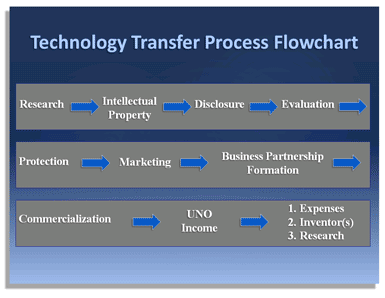Technology Transfer Process
A step by step overview of the process: from research, to licensing and on to commercializing.
A step by step overview of the process: from research, to licensing and on to commercializing.

The research can be funded by Federal, State, and/or Internal UNO funds or by a direct contract from Industry.
To be patentable, an invention must be new, useful, non-obvious and enabled.
It is limited to the discovery or creation of a new material, a new process, a new use of an existing material, or an improvement of any of these. "Material" in this context encompasses a new manufactured product, a new composition of matter, or a genetically engineered product. In certain circumstances, computer software is also considered a patentable invention. The inventor prepares and submits a Technology Disclosure Form to the Office of Technology Management and Commercialization.
After the OTMC receives the Technology Disclosure Form, it will be reviewed for completeness. It will then be logged into the system, assigned a case number and an acknowledgement letter will be sent to the inventor. Next an initial meeting will be scheduled with the inventor. Depending on the availability of the inventor, this meeting will generally be scheduled within two weeks of the submission of the Technology Disclosure.
In completing the Technology Disclosure Form it is important to pay particular attention to question 9(f) which deals with sponsorship. If the Technology Disclosure Form lists funding support from an industrial sponsor, the appropriate agreement will be consulted to determine if any pre-existing obligations were conveyed to the sponsoring company in the contract. For example, commonly an industrial sponsored research agreement will include terms that convey certain rights to inventions developed during the performance of the project to the sponsor. These rights most often include an option (right of first refusal) with specific notification requirements and duration, or limited license rights to inventions. Therefore before we can market the technology to outside companies we must first determine what rights may belong to the industrial sponsor, the notification (form and timing) required, and if necessary offer the sponsor an option to the technology. If the invention was "conceived or first actually reduced to practice in performance" of a federally funded project than federal law (Bayh-Dole) would apply. One of the key provisions of Bayh-Dole is a requirement to notify the sponsoring agency (e.g., NSF, NIH, NASA, Dept of Defense, etc.) within 2 months of receipt of the ROI. To assist us in complying with this obligation please be sure to include on the ROI the grant number issued by the federal agency (not the project proposal number but rather the actual grant award number).
In our assessment of the technology we generally begin by determining whether or not the discovery is patentable. The criteria for patentability are that the invention must be novel, useful, non-obvious and enabling. Typically we will conduct a "prior art" search (a search of the worldwide patent and technical literature) in order to evaluate the novelty of the invention. Our findings are shared with the inventors and their opinions considered as a part of our evaluation.
As part of our evaluation we also analyze factors of commercial relevance. Among these are the invention's state of maturity, development risk, need for other background patent licenses, and market size or scope. Depending on the faculty member's interest in entrepreneurship, in some cases we may find that the best route to commercialization is through a faculty spin-out company. We work closely with the faculty member to identify platform technologies that could be the basis of a new business, or that requires further advancement within a development company before it is a viable licensing candidate.
Based on the assessment results, a decision is made to file a US patent application. If the decision is to file, then the inventor's role is to assist the patent attorney in the preparation and prosecution of the patent. The time from filing a patent application to patent issuance can vary from 2-3 years, though it can sometimes take much longer. If the decision is not to file, the technology may offered back to the inventor and he or she given the option of paying the costs at his or her own expense.
If the technology is found to be patentable, commercially viable and unencumbered our next steps are to conduct market research to identify likely licensing candidates and market the intellectual property to industry. We pay particular attention to finding opportunities for regional economic development, e.g., license to a Louisiana-based firm. Very often the inventor is an excellent source of leads as they may receive inquiries from industry scientists about the work as a result of recent publication or presentation at a meeting or conference. We usually start by drafting an executive summary of the technology designed to convey the key features and advantages of the invention while not revealing sufficient detail to create an issue of "public disclosure" for the purposes of patent law. Since the inventor is the most knowledgeable about the technology, we often ask the inventor to assist us in writing the executive summary.
Assuming that a willing and qualified licensee can be found, negotiation over a suitable license agreement is begun. Recent years have seen a bewildering variety of licensing alternatives, with the acceptance of equity by the university in a license being one strategy adopted by many universities. Identification of the correct recipe of reasonable royalty payments industry-appropriate milestone payments, commercialization goals, and termination provisions calls for both current intelligence and the skills of a seasoned license negotiator. Normally the role of the inventor in such negotiations is akin to the relationship between a realtor and home seller.